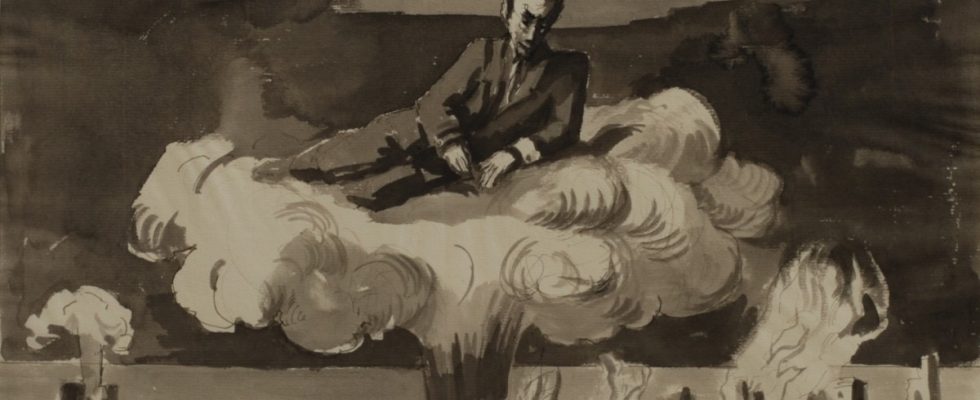The title has a double meaning. “Wanderer Between Worlds” is the name of the Augsburg exhibition that traces the long-standing friendship between Bertolt Brecht and the set designer Caspar Neher. The show leaves no doubt that Brecht’s childhood friend is one of the most important stage designers of his time. But it also sheds light on an aspect that other Neher exhibitions tend to ignore: his work during the Nazi era. In contrast to Brecht, who actually traveled the world, Neher always stayed in Germany and had no problem moving about in the world of the Nazis.
The stage designer and the writer, both born in Augsburg, one in April 1897, the other in February 1898, met as students at the Realgymnasium and quickly became close friends. Their artistic collaboration begins early, with Neher illustrating Brecht’s early literary attempts. The fact that the two are very different characters is revealed by their contrasting attitudes towards the First World War. Neher volunteers. Brecht, who tries everything to avoid being drafted, has absolutely no sympathy for his national enthusiasm and leaves not the slightest doubt about it in his letters. “You may be an idiot… you are to blame for everything that comes over you…”
Sketches, watercolours, caricatures and illustrated diary entries document the close relationship the friends have with each other. In 1924 Brecht went to Berlin. Neher follows and, with his stage designs, made a significant contribution to his success in the Weimar Republic, as he created the stage sets for Brecht’s and Kurt Weill’s “The Threepenny Opera” and “The Rise and Fall of the City of Mahagonny”.
The National Socialists ensure that the friends separate. In contrast to Brecht, who went into exile, Neher stayed and, after a short professional ban, integrated himself into the National Socialist cultural scene, but retained his own reduced style. From 1934 he made stage sets for plays by Hans Friedrich Blunck, Erwin Guido Kolbenheyer, Hans Leip, Gerhard Schumann and Eberhard Wolfgang Möller, working for the top ranks of Nazi poets. Which doesn’t bother Brecht at all when he got in touch with Neher again after his return from the USA.
As far as Brecht is concerned, not an isolated case, says Jürgen Hillesheim, curator of the show and head of the Brecht Research Center. In his view, from the late 1940s Brecht deliberately sought out close contact with former prominent Nazi theater people, at least when it seemed strategically useful to him. This only suited the theater greats, still in the “post-National Socialist self-purification process” (Hillesheim). If they put pieces by the alleged communist and East German figurehead on the repertoire, they were considered progressive or at least refined.
A self-portrait by Caspar Neher from the 1920s.
(Photo: Andreas Brücklmair)
Brecht, on the other hand, absolutely wanted to be present on West German stages. “I can’t sit down in any part of Germany and be dead to the other part,” Hillesheim quotes him as saying. In his efforts to bring the “Threepenny Opera” back to the stage, Brecht turned to the actor, Ufa star and crowd puller Hans Albers, for example. He wrote to him that in order not to jeopardize the success of the play, he had created a version “where I took out the cripples that one might take offense at today”. The version with Albers as Macheath was performed by the Munich Kammerspiele in 1949, with the stage equipment naturally coming from Neher. Incidentally, Brecht’s constant maneuvering and tactics annoyed him quite a bit.
Around 40 exhibits from the holdings of the art collections and the Brecht collection of the State and City Library are spread over the two small rooms of the Graphic Cabinet, including a series of drafts for Brecht’s “Fear and Misery of the Third Reich”, planned for the Swiss premiere 1947 in Basel, or the unfinished drama fragment “The Chariot of Ares” from 1948. A special find from the depot is a heroic standard-bearer that Neher designed for Brecht’s drama “Saint Joan of the Slaughterhouses” (1922). The grisaille oil study served as a model for the cover of the first edition, which appeared in 1932.
Neher designed this motif for “Saint Joan of the Slaughterhouses”, which also served as a template for the cover of the first edition.
(Photo: Andreas Brücklmair)
The exchange of letters between the stage designer and Rolf Badenhausen from 1952 to 1960 also shows how well the old cliques worked. Badenhausen, during the Nazi era acting dramaturg under Gustav Gründgens at the Prussian State Theater, was only deputy general manager at the Düsseldorfer Schauspielhaus at this time – his boss was called Gründgens again – then assistant to the general director at the Württemberg State Theater in Stuttgart. He persuaded the latter to put “The Life of Galilei” on the programme, naturally with Neher’s stage design. It was directed by Günter Rennert, later director of the Bavarian State Opera, who had worked with Neher repeatedly during the Nazi era.
Incidentally, it was also Badenhausen who curated the first major Neher exhibition in Augsburg in 1964. He completely omitted his stage work under the Nazi dictatorship, true to the guiding principle that Neher had set up in 1945. “Let’s forget what happened as quickly as possible.”
Wanderer between the worlds – The friendship Caspar Neher – Bertolt Brechtuntil June 25, Grafisches Kabinett, Maximilianstraße 48, 86150 Augsburg.

